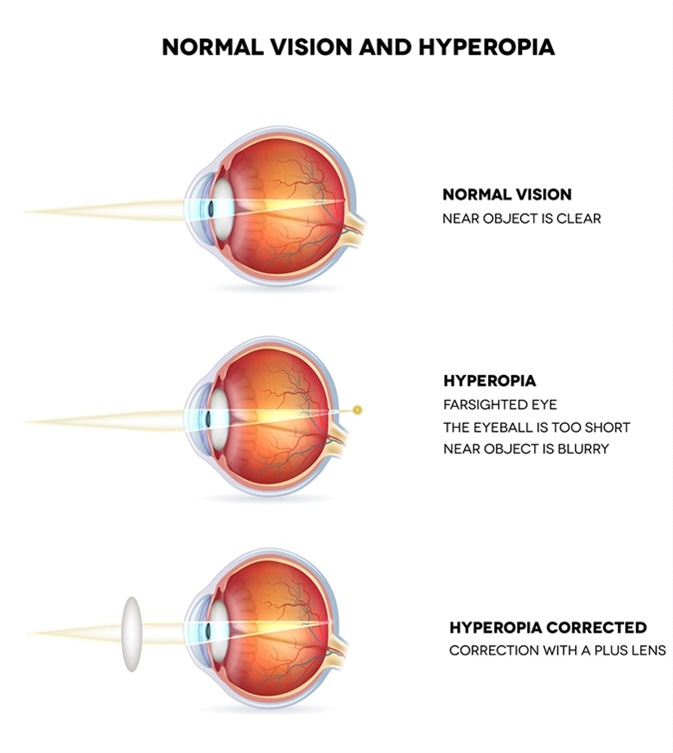Nearsightedness and Farsightedness

Nearsightedness (myopia) and Farsightedness (hyperopia or presbyopia) are well-known refractive errors or refractive eye diseases. According to the World Health Organization (WHO), there are approximately 5 million people who have lost their vision because of refractive eye errors.
In addition, around 124 million people around the world have been affected by refractive low vision problems. Eye glasses and contact lenses are the most common method to correct the refractive low vision problems. In more severe cases, surgical methods are followed to correct the vision.
What is Nearsightedness?
Nearsightedness, also known as myopia, is one of the types of refractive error. In myopia, the eyeball is too long and the cornea is steep, and because of this, the light rays focus is in front of the retina. Hence a person with myopia can see closer objects clearly, but distant objects are blurry. Nearsightedness can be detected during childhood.
.jpg)
Causes of Nearsightedness
The causes of nearsightedness are unidentified; some studies suggest that it is a hereditary problem. If the parents have myopia, their children are at a higher risk to develop it. Myopia can also develop if the cornea is curved for the eyeball length or if a lens is too thick. It can also be caused by a couple of problems that can occur in the cornea, eyeball length, and lens.
Research is being carried out to review the effects of age, sex, and ethnicity in the development of myopia in humans. Scientists say that spending a lot of time in front of the computer, reading, writing, insufficient time spending in natural sunlight (to list just some of the causes) may worsen the condition of myopia.
A recent development in research on this topic is that the circadian rhythms (i.e. the human biological clock) which adjust the human body on the basis of daily cycles of day and night can also be a factor that leads to myopia.
Symptoms of Nearsightedness
- Inability to see distant objects clearly
- Distant objects will appear blurred
- Squint the eyes to see distant objects or eyes need to be partially closed
- Headaches related to eyestrain
- Reading disability while driving, especially not able to read road signs during night
- Difficulty for children to see what is written on the blackboard at school
- Sitting and watching the television very close to it.
Treatment for Nearsightedness
Eye glasses are the easiest way to solve myopia. For people who use contact lenses they represent the first refractive surface; thus the light rays enter this refractive surface, which helps to get a clear vision. Sometimes the laser beam is used to change the shape of the cornea and provide better vision.
Refractive Surgery modifies the shape of the cornea permanently and minimizes or completely eliminates the use of eye glasses or contact lenses. There are many types of refractive surgeries, some of which are as follows:
LASIK surgery: In this surgery, an ultraviolet laser is used to remove a thin tissue from the inner layer of the cornea. By this, the cornea is reshaped and the light rays focus directly on the retina.
PRK surgery: To change the shape it removes the thin layer of tissue from the outer surface of the cornea. The cornea gets a new shape and lets the light to focus on the retina more precisely.
Phakic Intraocular Lenses (IOLs) represent a new technology for nearsighted people or for people with thin corneas. Surgical procedure is carried out to place this lens inside the eye.
What is Farsightedness?
Farsightedness also known as hypermetropia is a problem that affects the ability of the eye to focus. If farsightedness is related to age, it is called as presbyopia. In both the cases, people can see distant objects more clearly than the closer object, which looks blurred.
Farsightedness occurs if the eyeball is short and prevents the light rays to focus on the retina. The blurring of image is because the light focuses behind the retina as the cornea and the lens bend the light rays inward.

Causes of Farsightedness
The main causes of hypermetropia are shortness of the eyeball, weak focusing power, as well as irregular shape of the cornea or lens. Hereditary is one of the causes of hypermetropia/farsightedness, it may come from parents to child. Presbyopia/farsightedness can occur in the natural aging process.
Symptoms of Farsightedness
- Inability to see closer objects
- Distant objects will appear clearly
- Squint the eyes to see closer objects
- Headaches related to eyestrain
- Difficulty in reading small print, holding the reading objects at an arm’s distance to read
Treatment for Farsightedness
The eye care professional conducts the dilated eye examination, and the first step is to give prescription for eye glasses or contact lenses. This is the simpler and more commonly followed method in correcting refractive errors. Contact lenses are safe and cause a more accurate refraction of the light rays for people with the farsightedness problem.
Refractive surgery may also be used, and there are many types of surgical options available to correct farsightedness that is corneal, sclera, and lenticular based. These types of surgeries aim to increase the focusing power.
Sources
- www.hpb.gov.sg/…/singapore-achieves-breakthrough-in-reducing-prevalence-of-myopia-by-almost-5
- https://nei.nih.gov/health/errors/myopia
- http://www.studenthealth.gov.hk/psi/prod/english/health/myopia_en.pdf
- www.betterhealth.vic.gov.au/…/short-sightedness
- https://medlineplus.gov/ency/article/007018.htm
- https://nei.nih.gov/healthyeyes/hyperopia
- www.nei.nih.gov/sites/default/files/health-pdfs/Farsightedness.pdf
- https://medlineplus.gov/ency/article/001020.htm
- https://www.ncbi.nlm.nih.gov/pubmed/27257729
Last Updated: Aug 23, 2018

Written by
Dr. Tomislav Meštrović
Dr. Tomislav Meštrović is a medical doctor (MD) with a Ph.D. in biomedical and health sciences, specialist in the field of clinical microbiology, and an Assistant Professor at Croatia's youngest university – University North. In addition to his interest in clinical, research and lecturing activities, his immense passion for medical writing and scientific communication goes back to his student days. He enjoys contributing back to the community. In his spare time, Tomislav is a movie buff and an avid traveler.
Source: Read Full Article




